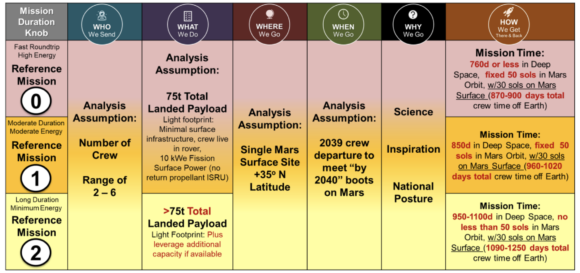In December 2017, the Trump administration changed the course of NASA’s manned program by changing the priority of space policy from the White House. Mars will not be the next target of the American manned program, as it was under Obama. Now it will be the moon, as it was a decade ago during Bush Jr.’s ill-fated Constellation program. Two years later, the Artemis program to return humans to the Moon by “recycling” the SLS-Orion system was officially born. But although it is no longer the number one priority, Mars has not disappeared from US space policy. In fact, Trump limited himself to placing the moon in front of the red planet, but he did not erase the neighboring planet as a next destination. of manned flights. Now, with all of NASA’s resources dedicated to the Artemis program, is a crewed trip to Mars possible? To analyze this possibility, the space agency has just published a study titled “Architecture from the Moon to Mars,” or M2M for short (Moon to Mars).

The document makes clear that manned flights beyond low orbit are intended to inform and inspire new generations, as well as the global influence of the United States and the maintenance of international relations. Also, remember that the goal of the Artemis program is to explore the lunar south pole and eventually establish a lunar base in that area (the same goals as the Chinese space program). The Artemis program will allow NASA to acquire the SLS rocket, the Orion spacecraft and the Gateway lunar station, as well as the HLS (Human Landing System) lunar module from SpaceX, launched by the world’s largest orbital rocket, the Starship system. Can you go to Mars with these items? The question is intriguing to say the least because, as we all know, Elon Musk developed the Starship system with the stated goal of colonizing Mars. In other words, don’t just take humans, but build real cities on the red planet. This is why it is surprising that the document did not mention the spacecraft Not even once.


It is true that the document does not go into the technical details of a future mission to Mars, but only shows how the Artemis infrastructure can be used to plan manned missions to the neighboring planet. However, ironically, the Starship’s capabilities for this mission are not clearly stated. In any case, the report suggests that NASA revise the goals of the Artemis lunar missions starting with Artemis IV so that it can simultaneously serve as a test bed for technologies and procedures related to a trip to Mars. The Artemis missions will allow two people to walk on the moon for approximately six days each year until, starting with the Artemis VIII mission, a small lunar base will be available to allow for extensions of these stays. These stays, along with longer stays aboard the Gateway station, can be used to plan a trip to Mars (this is reminiscent of the old proposal to convert the Gateway station into an interplanetary spacecraft to gain experience in long-term manned flights into deep space).





Likewise, Artemis could use technologies that could later be adapted to Mars, such as ISRU (on the Moon to use Antarctic ice and on Mars to use Martian ice and atmosphere), store cryogenic propellants for long periods of time or develop advanced electricity generation systems such as compact nuclear fission reactors. (Kilopower Project). It will also analyze the biological effect of the underground gravitational field, the interaction between astronauts and unmanned probes and the effects of radiation on the human organism outside the protection of the Earth’s magnetosphere. A manned flight to Mars will be the fourth and final phase of the M2M strategy, after the initial return missions to the Moon (Artemis I to III), exploration missions and more complex “continuous lunar evolution” missions. The report indicates that it would be desirable to abandon the traditional division of Mars missions between opposition-type missions – short periods of a month – and those of the conjunction type – long periods of more than a year – and create more flexible hybrid missions.




The door is left open for the introduction of different forms of propulsion in addition to chemistry, such as solar electric (SEP), nuclear electric (NEP) or thermonuclear (NTP). For surface ships, the options are vehicles with inflatable heat shields — which NASA has studied — or “vertically-landing chemical rockets” (a euphemism for not saying spacecraft). For long-range missions, all-electric chemical or solar propulsion is preferred, while for short-range missions it is necessary to use propulsion with fission reactors, either with thermal or electric (ion or plasma) engines. Reference is also made to Mars spacesuits, which would have to be lighter than lunar suits due to Mars’ greater gravity and would have a different cooling system (the sublimation device in EVA vacuum suits would not work well in the Martian atmosphere). Mars).






In short, no one expects to see specific dates or a detailed structure for NASA explaining how to go to Mars. The M2M strategy aims to remember that after the moon comes Mars. And if this contract is for the Moon, then from the next NASA wants to make a manned mission to Mars a reality (so you can see, without paying attention to the plans of SpaceX). Another thing is that budgets or geostrategic priorities allow.

References:
- https://www.nasa.gov/MoonToMarsArchitecture
- https://ntrs.nasa.gov/api/citations/20230002706/downloads/M2MADD_ESDMD-001(TP-20230002706).pdf
- https://www.nasa.gov/sites/default/files/atoms/files/m2m_strategy_and_objectives_development.pdf

“Beer enthusiast. Subtly charming alcohol junkie. Wannabe internet buff. Typical pop culture lover.”
